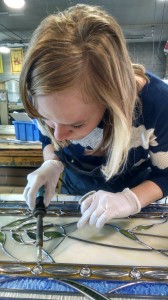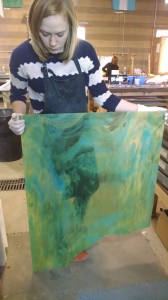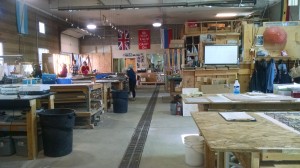
Patrons await an LDS temple dedication by tracking its outdoor construction process. What the public doesn’t see is the intricate workings of the interior walls.
Hannah Bradford, however, gets a firsthand look at the beauty inside the construction sites. She creates the stained-glass windows that grace the interior and exterior of temples worldwide.
Bradford, an artist at Holdman Studio at Thanksgiving Point, has worked on windows for temples in Gilbert, Arizona; Payson, Utah; Cordoba, Argentina; Rome, Italy; Sapporo, Japan and Paris, France.
Each temple and its glasswork is different in style and size. The Payson temple has more than 1,200 windows. The Cordoba Temple only has 133 windows, while the Gilbert Temple has about 300.
More temples for the LDS Church means more work for Bradford.
How it all began
Bradford graduated from BYU in 2012 from the visual arts program, with an emphasis in illustration. She moved from Utah to stay with her sister in Minnesota but eventually came back for her sister’s wedding.
When Bradford realized she financially couldn’t go back to Minnesota, she was introduced to the job at Holdman Studio.
“She’s very good with her hands,” said Bradford’s sister, Sarah Denzer. “She has a lot of skill with detail and fine-art-type of work, so I just thought she was a really good fit.”
The artist was reluctant to both start the new job and to stay in Utah but soon realized it was a part of her plan.
“It’s not quite what I studied,” Bradford said. “But it keeps my creative juices flowing.”
Denzer, who also works at the studio, trained her sister in the process and said she is one of the most efficient workers at the studio.

“Some people are so detailed, and everything has to be so accurate that they tend to fall behind on production because they want to have the best of the best, which is great,” Denzer said. “But Hannah has found a way to balance that good skill with details along with speed.”
The project manager at the studio, Jackson Mecham, said Bradford is an ideal worker. “She knows her craft very well,” he said. “She’s not one of the most tenured employees, but she has been a very fast learner. She’s definitely one of the people I rely on the most in the projects.”
The process
Bradford said a temple stained-glass window project begins when a studio makes a bid to the Church with a time frame and a budget in which it can do a project. The Church decides on a bid and sends a basic design to the studio.
That design becomes the main template for designing more elaborate windows. Artists at the studio start creating the windows when the Church approves them.
Most temple stained-glass windows are made of pieces cut out from sheets of colored glass. A machine called a water jet shoots water and sand at a certain speed to cut out the pieces.
The water jet is used for mass-produced pieces, but artists also use a tool to cut out pieces when they want a particular color pattern on a spot of the sheet of glass.
Bradford mainly works in the most precise part of making the windows: the building process.
She assembles the window using narrow strips of lead called lead channels. The channels have breaks that act as holders for the glass. The lead bends to fit the shape of each glass piece.
Once she lays each piece down to form the window, Bradford uses flux, a type of wax, to stick solder, a metal made of 60 percent lead and 40 percent tin, to joints in the channels. The soldering iron melts the channels together.
Bradford said making the windows isn’t difficult to learn, but having an artistic background makes it easier to pick up.
“They want you to be precise,” she said. “You can’t have gaps in your window because when you put down the iron, the solder would go all over the place. So you have to be quick about it, but you also have to produce quality work.”

The future
Bradford said her ultimate goal is to do freelance artwork, but she said it’s near-impossible.
“There are a handful of people who can do their own stuff and put it in galleries,” Bradford said. “But my style of art isn’t like that.”
Bradford said she doesn’t have a single style, but she likes to work with ink and paint, doing figures. She likes to make things look real but adds her own flair to it. Bradford wants to make a book of her childhood, but without words.
Seeing finished windows at the temple brings Bradford deep satisfaction. “When you go in it’s the most amazing thing,” she said. “You go in and you’re like, ‘Ah, I’m in the celestial room! I’m looking at a window that I built.’ It’s intense.”
Temple dedications inspire Bradford to see the value in what sometimes seems like “just” work.
“When they dedicate a temple that you’ve worked on, the Lord (knows and) is accepting the work that you put into it,” she said. “It’s like Heavenly Father is saying, ‘It’s beautiful, and it’s my home.’ And that’s cool. Really cool.”




